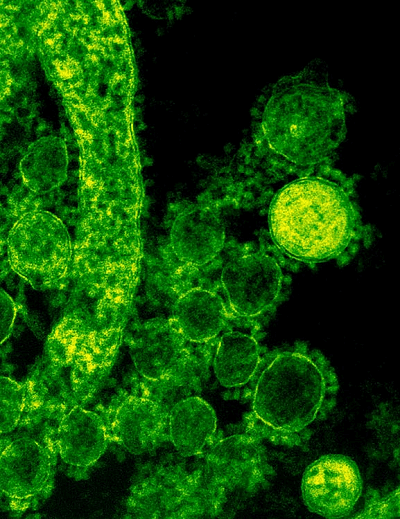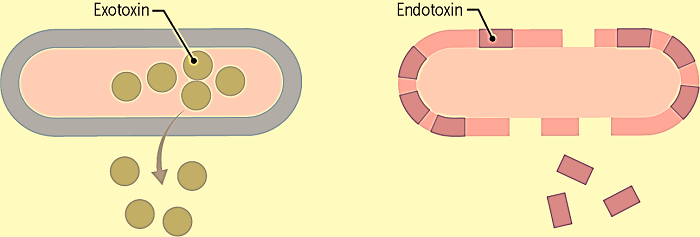Difference Between Endotoxin vs ExotoxinsTwo different categories of toxins generated by bacteria are endotoxins and exotoxins. These toxins have various sources, structures, and modes of action and can result in serious illnesses. Since they have an impact on the diagnosis and management of bacterial infections, endotoxins, and exotoxins require different understanding. The main differences between endotoxins and exotoxins, their physiological consequences, and why it's important to identify the type of toxin causing an illness will all be covered in this article. This article will provide you with important insights into the world of toxins and their effect on human health, whether you're a healthcare professional or just want to learn more about bacterial diseases. 

What are Endotoxins?Endotoxins are toxins found in certain gram-negative bacteria's outer membrane. A form of bacterium known as gram-negative bacteria has a thin cell wall and is frequently more resistant to medications. As these bacteria die or are eliminated, endotoxins are produced. Endotoxin discharge may trigger an inflammatory reaction in the body, which may result in fever, shock, or even death. Lipopolysaccharides (LPS), which are substantial molecules consisting of lipids and sugars, are the building blocks of endotoxins. Gram-negative bacteria only produce LPS, which are essential to their existence. LPS is a component of this bacteria's outer membrane, which aids in shielding them from the human immune system. Endotoxins are produced when the bacterial cell wall is damaged rather than being secreted by active bacteria. This may take place because of antibiotic therapy, an immune system response, or even just as part of the bacteria's normal life cycle. Endotoxins can induce a variety of symptoms when they are released into the body, including fever, chills, nausea, vomiting, and diarrhoea. What are Exotoxins?Exotoxins are toxins produced by gram-positive or gram-negative bacteria that are still alive. Exotoxins, unlike endotoxins, do not form a component of the bacterial cell wall. Exotoxins are proteins that bacteria make and subsequently discharge into the environment. After that, these toxins can enter the body and have a variety of negative effects. Many bacteria, such as Staphylococcus aureus, Streptococcus pyogenes, and Clostridium botulinum, generate exotoxins. Each form of exotoxin has a distinct structure and mode of action that enables it to produce particular bodily symptoms. Cytotoxins, neurotoxins, and enterotoxins are the three main subgroups of exotoxins. Neurotoxins disrupt the neurological system, whereas cytotoxins harm or kill cells. Enterotoxins affect the digestive system and can result in symptoms like vomiting and diarrhoea. How do Endotoxins and Exotoxins Affect the Body?There are two classes of toxins that bacteria can create that can be harmful to humans: endotoxins and exotoxins. The outer membrane of Gram-negative bacteria contains a form of a toxin called endotoxins. Endotoxins are released into the environment when these bacteria die. Fever, inflammation, and shock are just a few of the symptoms that can be brought on by endotoxins. Endotoxins are identified by the body's immune system as foreign substances, and this triggers an inflammatory reaction to get rid of them. Yet occasionally, this reaction may be excessive, resulting in sepsis, a disease that can be fatal. Both Gram-positive and Gram-negative bacteria may create and emit exotoxins, a particular kind of toxin. These toxins have two possible fates: they may either be discharged into the environment, or they can stick to the bacterial cell wall. Depending on how they are used by the body, exotoxins can have a variety of consequences. Exotoxins can interfere with host cell signaling pathways or immunological responses, while others can harm host cell membranes and cause cell death. Exotoxins can induce a variety of symptoms, such as the paralysis of muscles brought on by botulinum toxin or the excruciating diarrhoea brought on by cholera toxin. Exotoxins and endotoxins both have serious negative effects on human health. In addition to their immediate effects, exposure to these toxins over time has been associated with chronic inflammatory disorders including atherosclerosis in the case of endotoxins and cancer in the case of some exotoxins. Avoiding contact with bacterial infections that create endotoxins and exotoxins is the greatest strategy to counteract their negative effects. This may be accomplished by taking steps like cleaning your hands, handling your food properly, and being vaccinated against bacterial infections. Diseases Caused by Endotoxins and ExotoxinsA variety of bacterial illnesses, each with its own specific set of symptoms and side effects, can be brought on by endotoxins and exotoxins. The following are a few frequent diseases brought on by endotoxins and exotoxins: EndotoxinsSome of the diseases caused by endotoxins include:
ExotoxinsExotoxins are linked to a number of illnesses, including:
Long-term exposure to endotoxins and exotoxins has been associated with chronic inflammatory disorders including atherosclerosis and cancer in addition to the acute consequences of these toxins. Hence, limiting exposure to bacterial pathogens that generate endotoxins and exotoxins is essential for limiting their negative consequences. Diagnosis and Treatment of Endotoxin and Exotoxin-Related DiseasesThe specific disease and its severity will determine how endotoxin- and exotoxin-related disorders are diagnosed and treated. Following are some typical methods for identifying and treating these illnesses: DiagnosisDiagnoses are made using a mix of clinical examinations, laboratory testing, and imaging investigations for disorders associated to endotoxins and exotoxins. Blood cultures, serologic tests, polymerase chain reaction (PCR) testing, and imaging investigations including X-rays and computed tomography (CT) scans are a few of the typical procedures performed to detect these disorders. TreatmentThe severity of the condition and its underlying cause will determine how endotoxin- and exotoxin-related disorders are treated. The following are some typical therapies or treatment for these illnesses include:
To avoid additional infections, it's crucial to find and get rid of the source of endotoxins and exotoxins in along with the previous therapies. This may entail taking steps to ensure food safety, maintain good hand hygiene, and prevent infections in medical facilities. A mix of clinical examination, laboratory testing, and imaging investigations are used in the diagnosis and treatment of endotoxin- and exotoxin-related disorders. Treatment options might include antibiotics, antitoxins, supportive care, and immunisation depending on the disease's severity and underlying cause. To stop subsequent infections, it's critical to locate and get rid of the exotoxin and endotoxin sources. Prevention of Endotoxin and Exotoxin ExposureTo prevent the onset of disorders brought on by these poisons, endotoxin and exotoxin exposure must be prevented. The following are some strong precautionary measures:
To prevent the onset of disorders brought on by these poisons, endotoxin and exotoxin exposure must be prevented. Endotoxin and exotoxin exposure can be avoided by good hygiene habits, food safety precautions, immunisation, avoiding contaminated settings, infection control procedures, and prudent antibiotic usage. Similarities between Endotoxins and ExotoxinsEndotoxins and exotoxins do have some commonalities despite their distinctions. Both kinds of toxins can result in fever, chills, exhaustion, aches and pains in the muscles, and inflammation. However, both of them have the potential to cause more specialised symptoms such neurological ones, vomiting, and diarrhoea. Both kinds of toxins can also be extremely strong and result in serious disease or death. Difference between Endotoxins and ExotoxinsEndotoxins and exotoxins are two different types of toxins produced by bacteria that can cause various diseases in humans and animals. Here is a table highlighting the differences between endotoxins and exotoxins:
ConclusionEndotoxin and endotoxins are similar but different ideas in microbiology and immunology, to sum up. A specific kind of toxin called endotoxin, which is located in the outer membrane of Gram-negative bacteria, can lead to sepsis and systemic inflammation. Contrarily, endotoxins are a more inclusive word that includes both exotoxins and enterotoxins as well as any toxin generated by a microbe. It is crucial to comprehend the differences between endotoxins and endotoxins for a number of reasons. In order to accurately diagnose and treat infectious illnesses, it might be helpful to first understand the terminology used in clinical practise and scientific study. Second, it draws attention to the distinct characteristics and biological mechanisms of endotoxin, which can help in the development of novel treatments for sepsis and associated diseases. While they differ, endotoxin and endotoxins both contribute significantly to the development of infectious illnesses and immunological responses. The complicated interplay between microbial toxins and host defenses will continue to be clarified by ongoing research in this area, opening the door for fresh approaches to the prevention and treatment of infectious illnesses.
Next TopicDifference between
|
 For Videos Join Our Youtube Channel: Join Now
For Videos Join Our Youtube Channel: Join Now
Feedback
- Send your Feedback to [email protected]
Help Others, Please Share










